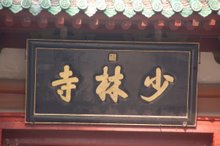
 What is missing may be more important to the curiosity – especially of our American readers: a visit to Dharma Cave, and pictures of Shaolin Kung Fu. On the day of our visit we were told that the Shaolin monks only do public exhibitions during certain times
What is missing may be more important to the curiosity – especially of our American readers: a visit to Dharma Cave, and pictures of Shaolin Kung Fu. On the day of our visit we were told that the Shaolin monks only do public exhibitions during certain times of the year. This owes in large part to the fact that today only a few monks actually live on the compound: there just isn’t enough room – especially since the compound is besieged daily with bus loads of tourists.
of the year. This owes in large part to the fact that today only a few monks actually live on the compound: there just isn’t enough room – especially since the compound is besieged daily with bus loads of tourists. There are several schools just outside the entrance of the compound. We saw one of them driving up to the gate; and took a picture from the taxi. It is displayed here at the end of the menu, on the left. We also learned, a few months after our visit, that there is another training ground beyond Dharma Cave, where we might have been able to observe the monks’ training.
 Our hope is that we will be able to return in 2007 – armed with a little more information. As soon as that happens we will update this blog with more pictures. Meantime we have added a brief entry below, and also included a few links to pages with loads of information about Shaolin Kung Fu.
Our hope is that we will be able to return in 2007 – armed with a little more information. As soon as that happens we will update this blog with more pictures. Meantime we have added a brief entry below, and also included a few links to pages with loads of information about Shaolin Kung Fu.
Martial Arts
The Shaolin monastery is the only temple in China that combines martial arts and Chan Buddhism As such, monks at the monastery may be martial monks, scholarly or clerical monks, or both. However, even the martial monks also practice Chan Buddhism. It is said that Chan Buddhism allows you to store and build up qi, while martial arts is the act of releasing qi; therefore, the two complement and complete each other. Because of this dual focus, there are two abbots at the Shaolin Temple. The current martial abbot is Shi De Li, the thirty-first direct successor after Bodhidharma, or Da Mo.
The Shaolin monastery is the only temple in China that combines martial arts and Chan Buddhism As such, monks at the monastery may be martial monks, scholarly or clerical monks, or both. However, even the martial monks also practice Chan Buddhism. It is said that Chan Buddhism allows you to store and build up qi, while martial arts is the act of releasing qi; therefore, the two complement and complete each other. Because of this dual focus, there are two abbots at the Shaolin Temple. The current martial abbot is Shi De Li, the thirty-first direct successor after Bodhidharma, or Da Mo.
As martial abbot, the primary job is to train monks in gongfu (kung fu). The monks have a very regimented schedule for training. For example, before even having breakfast, the trainees must wake up at 4 AM to run for an hour, to meditate for another hour, and train martial arts for a third hour. The monks do not get very much of a break; their only vacation is ten days near the Chinese New Year to see their parents. It must be noted, however, that this is reflective of the current schedule at Shaolin temple, and in no way reflects the historical focus or schedule of Shaolin prior to its most recent reconstruction. The current Shaolin temple is the subject of much controversy as many Chan Buddhist elements inherent in Shaolin training are no longer represented.
A different form of Shaolin Kung Fu called Shaolin-Do was created and is now practiced widely throughout the United States of America. Many question it's connection with Shaolin, however it's history roots from shaolin kung fu. http://www.answers.com/topic/shaolin


No comments:
Post a Comment